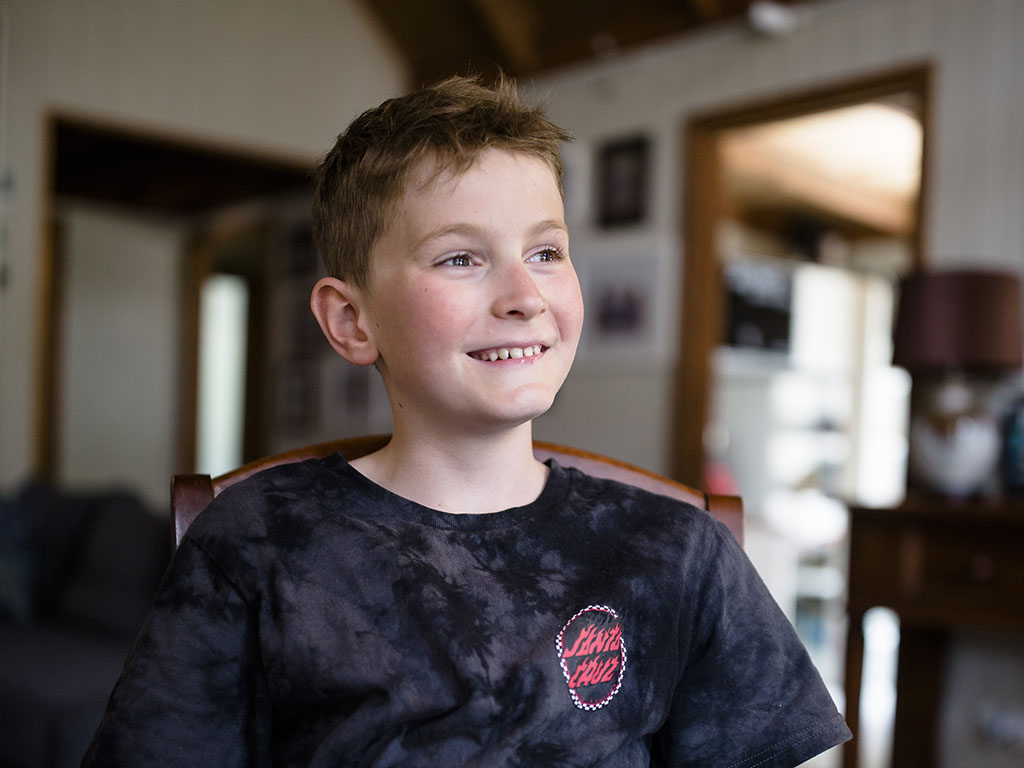Stories
Sky’s the limit
Sam’s parents struggled for years to obtain a diagnosis for his condition, but genetic research at CERA is finding answers.
Sam is 11. He loves designing and building things. He thinks that when he grows up, he might be an engineer.
“My favourite subject at school is STEM,” says Sam.
“We are designing rockets and then we are going to print them out on a 3D printer.
“We are going to go out on the school oval, then you add bi-carb soda and vinegar, shake it up and it goes really high into the sky.”
Like a rocket, Sam leaps high in to the sky in another of his favourite hobbies, trampolining.
For all his life, Sam has lived with low vision and photophobia which causes intense eye discomfort in bright light.
He relies on special glasses with a coloured filter to see.
“When Sam was a baby, he literally would not open his eyes outside,” says his mother, Ronelle. “And when he learned to crawl, he would avoid any brightly lit areas of the house.”
“It wasn’t until he was about four or five that he was able to see clouds for the first time – because the light wasn’t so bright, and he was able to see the contrast. He was amazed.”
Sam also experienced nystagmus – rapid involuntary movement of the eyes – but doctors weren’t able to provide a diagnosis or tell if his vision problems would get worse.
“I was worried Sam’s vision loss was progressive and wanted to know how to prepare for the future,” says Ronelle.
Sam’s father Dave recalls the frustration of trying to find support for an undiagnosed condition.
“It is hard to access services when you can’t put a name on something,” he says.

Decade to diagnosis
It took nearly 10 years for Sam’s family to get an answer.
Sam is part of VENTURE, a collaboration between CERA and the University of Melbourne. which aims to improve understanding of inherited retinal diseases (IRDs) and give more people the opportunity to take part in research.
It was thought Sam may have had a very rare IRD known as achromatopsia.
It was through his involvement with VENTURE that Sam’s family underwent genetic testing, which identified the genes associated with X-linked congenital stationary night blindness.
And after travelling overseas in search of answers, Ronelle and Dave are reassured that studies like VENTURE are now happening in Australia.
“There aren’t any treatment options, or gene therapy trials, for the condition Sam has,” says Ronelle.
“But if research can reduce the uncertainty for another family in the future, that will make a huge difference. So, if another child has a condition like Sam’s they won’t have to wait 10 years to get an answer.”
High hopes
In recent years, Sam’s vision has been stable.
After years of navigating the world with low vision – he’s resilient and optimistic.
He’s proud of the skills he’s developed at school, at play and on the trampoline, including perfecting a double front flip and
an ability to scale impressive heights at the trampoline park.
“At Bounce, there were three levels to jump from. Some of the other kids were a bit scared but I just went straight up to the top one.”
What is VENTURE?
IRDs are the most common cause of legal blindness in working-aged Australians.
The Victorian Evolution of Inherited Retinal Diseases Natural History Registry (VENTURE) is compiling groups of potential participants for the current wave of emerging treatments for IRDs.
VENTURE is led by Associate Professor Lauren Ayton and Dr Tom Edwards, and includes a team of more than 20 specialists.
“About 250 patients have already registered,” says Associate Professor Ayton.
“More than two-thirds now have a genetic diagnosis, so we know what genes cause their condition and can offer them access to new clinical trials and treatments.”
VENTURE is supported by the National Health and Medical Research Council, Retina Australia, the CASS Foundation and the Choroideremia Research Foundation (USA).
